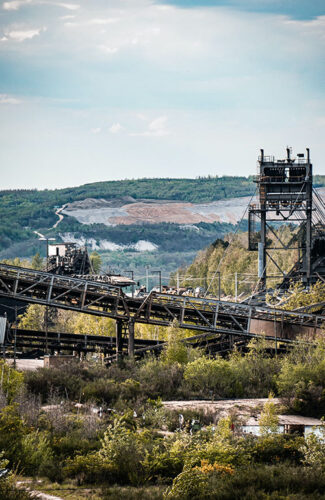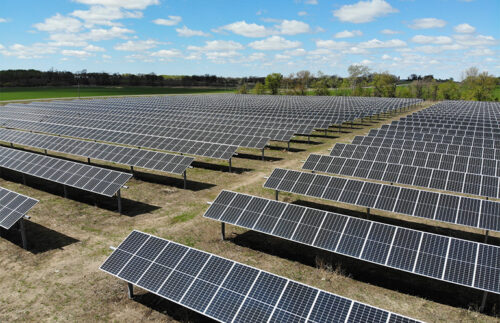-
- No megawatt-cap on this 10% bonus credit
- Energy communities can fall into three categories:
- Brownfields
- Former mine land with date limits
- Statistical areas affected by coal plant closures
- Developers that select the ITC for these projects can choose either testing a project for eligibility in the year construction started or the year a project is placed in service
- Developers that choose the PTC for these projects can choose either a single eligibility test the year construction started or a test every year during the 10-year PTC period
- For projects that started construction before 2023, developers can only select the year the project is placed in service for the ITC or every year of the 10-year period for the PTC
The “energy community” tax credit adder in the Inflation Reduction Act presents a potential renewable windfall to developers and could bring much-needed tax revenue to communities affected by the dissipating fossil fuel industry.
Solar projects are eligible for an additional 10% tax credit adder on top of the potential 30% investment tax credit (ITC) or production tax credit (PTC) if project sites meet the criteria for energy communities laid out by the IRS. Last fall, tax equity investors did not have enough clarity to feel confident investing in these projects, but that changed after new guidance was released in April 2023.
“As somebody who’s down in the trenches doing deals, the guidance did a nice job of bringing up a lot of difficult questions,” said Keith Martin, partner at Norton Rose Fulbright.
Energy community projects can fall into one of three categories:
 Brownfields
Brownfields
This category includes any project site that may be difficult to develop due to the presence of pollution or mine-scarred land.
“It’s basically to help promote development in areas that have been industrialized, and where redevelopment can be economically important,” said Gregory Wetstone, president and CEO of the American Council on Renewable Energy.
If a site is already on a Superfund or other government cleanup list, it must be analyzed further to ensure compliance. Developers will have to bring in environmental lawyers for that certainty.
Former mine land
The second category is any census tract or directly adjoining tract where a surface or underground coal mine closed after 1999, or a coal-fired generating unit was retired after 2009. Some mines may not appear in federal records or on Google Earth due to different access points or shifting locations of surface mines, so the IRS said it will allow developers to request additions of tracts.
“They left the window open to let developers try to persuade the government that other coal census tracts should be on the list,” Martin said.
Statistical areas
The final category is any location with a 0.17% or greater employment rate or 25% or greater tax revenues related to fossil fuel extraction, processing, transport or storage; and an unemployment rate at or above the national average unemployment rate for the previous year.
The IRS published a table that shows which statistical area each county in the United States falls into, along with a table showing which statistical areas meet the fossil fuel employment statistic. The IRS also published a map reflecting the current data on former mine land and statistical areas and will update the employment information after the Bureau of Labor Statistics publishes 2022 unemployment information. The government plans to publish an update every year in May with the latest statistics.
Solar projects qualify for the adder if at least half the nameplate capacity is located in an energy community; and storage projects qualify if at least half the storage capacity in megawatt hours is located in an EC.
Additional government funding and assistance is available for some of these projects, including $450 million from the Bipartisan Infrastructure Law to advance clean energy demonstration projects on current and former mine lands and Rapid Response Teams to provide targeted, on-the-ground assistance to communities and regions facing “acute and unique challenges.”
PTC vs. ITC considerations for EC projects
Choosing between the ITC and PTC is especially crucial when it comes to energy community projects. The most important factor in this decision is the year the project would classify as an energy community. Due to the elastic nature of the criteria — for example, a county could have a higher unemployment rate than the national average one year but lower the next; or a retired coal-fired power plant could resume production — companies will need to “test” for EC status on the year the project would qualify to receive the credit.
For projects placed in service in 2023 or later, developers have different choices to test a project’s energy community status. If they select the ITC, they can choose either the year construction started or the year a project is placed in service. If they select the PTC, they can choose a single eligibility test the year construction started or a test every year during the 10-year PTC period.
For projects that started construction before 2023, developers can only select the placed-in-service year for the ITC, or every year of the 10-year period for the PTC.
That caveat proves to be particularly difficult for PTC projects. Testing every year is clearly a nonstarter for financiers, who require the certainty that the 10% bonus credit is guaranteed for the lifetime of their investment.
“A lot of the projects in the market currently seeking financing started [construction] before 2023. If they opt for PTC, they will not be able to assure a tax equity investor will get the bonus for the full 10-year period,” Martin said.
Competitive projects
There is no gigawatt limit on this bonus credit like there is with the Low-Income Communities Bonus Credit Program. The only limit is the availability of sites that meet the criteria. The industry expects competition to be high.
 “I know from being out on the road talking to developers that they’re all keenly focused on these bonus credits. They are worth a lot of money,” Martin said.
“I know from being out on the road talking to developers that they’re all keenly focused on these bonus credits. They are worth a lot of money,” Martin said.
Community solar developer New Energy Equity is vying for as many of these credits as possible, starting with projects already in its development pipeline.
“We’re mostly verifying projects in the coal plant region or coal mine region zones, just because all that data and guidance has been released. We’re still keeping tabs on the potential employment statistical area zones,” said Josh Anderson, market and policy analyst at New Energy.
New Energy and other developers are working with lawyers like Martin to prove to investors they will qualify for the intended credits.
“From the financiers’ perspective, we’ll all need legal opinions and … legal support to be able to monetize the credits, because ultimately, if they don’t have a sign-off, we can’t represent those credits within our transactions,” said Eric Pasi, SVP of new market development and marketing at New Energy.
Martin and his team at Norton Rose Fulbright have seen an influx of requests for memos that can be shown to lenders, tax equity investors or tax insurers ever since the guidance was released. The memos can be difficult to write if the developer is unsure when construction will begin.
“I’ve been telling them, ‘Look, if you want certainty, you better start construction this year.’ That’s the way to lock in qualification,” Martin said.
Community benefits
Installing renewable energy in place of old fossil fuel plants is good for developers and the climate, but also for the communities impacted by coal plant closures. Former fossil fuel workers won’t necessarily be employed at scale to build new solar projects, since many are likely retired or moved on to other professions, but job opportunities could attract younger workers living in ECs.

A community solar project by New Energy Equity.
“Hiring the very same workers is a huge challenge. We’re going to see that happen, but maybe not as much as we would dream,” said Thom Kay, program manager for energy transition at the labor and environmental group BlueGreen Alliance.
Still, solar projects can bring some property tax revenue back and breathe new life into these communities. When coal plants shutter, the tax revenue that once funded a town’s basic needs disappears with them.
“The entire town suffers. They start laying off teachers, they have trouble with maintaining clean water supply, roads go to hell. Everything is reliant on getting some tax revenue,” Kay said.
The NC Sustainable Energy Association found North Carolina properties with solar developed on them paid nearly 2,000% more in property taxes than the land prior to installation. Solar increases the real property taxes paid on a parcel of land by classifying the land as having a “commercial” use, which increases the assessed real property taxes, according to NCSEA.
Large solar projects in energy communities can also serve as reliable energy sources after coal plant closures, especially when paired with batteries.
“Bringing in some new industry or some new utility-scale clean energy is also really important just for maintaining electricity throughout the area,” Kay said.
Brownfield and coal plant solar projects present some logistical and design hurdles that greenfield projects do not — including mounting considerations on contaminated land, excavation health and safety requirements — so the IRA bonus adder is important in drawing developers to these types of installations.
“There’s a need for an added incentive to make sure that those communities aren’t left behind,” Kay said. “We’ve been fighting for that sort of focus on energy communities for a long time, and it’s really clear that this administration takes that very seriously.”





I live in virginia we should be eligible for these benefits , here in southern counties for sure.
we have several coal plants now shut down.
since we are located in KY, most of the counties in the state qualify according the DOE/ITC map. We have been told this will also apply to manufacturing and commercial businesses installing solar in a qualifying county. Is this correct?
What about Super Fund Sites?
Hi Allan, Superfund sites may apply, but Keith Martin at Norton Rose Fulbright advises that developers consult with environmental lawyers to be certain.